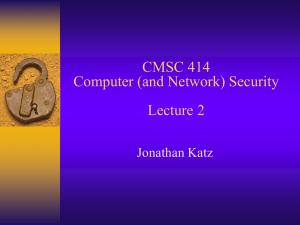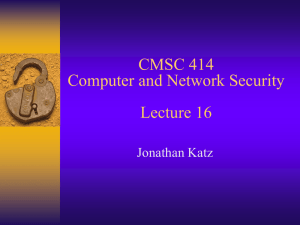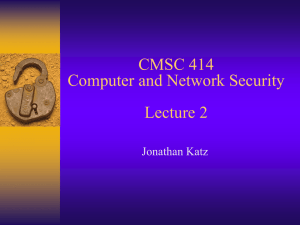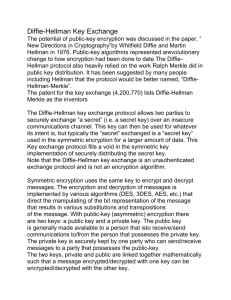CMSC 414 Computer and Network Security Lecture 2 Jonathan Katz
advertisement
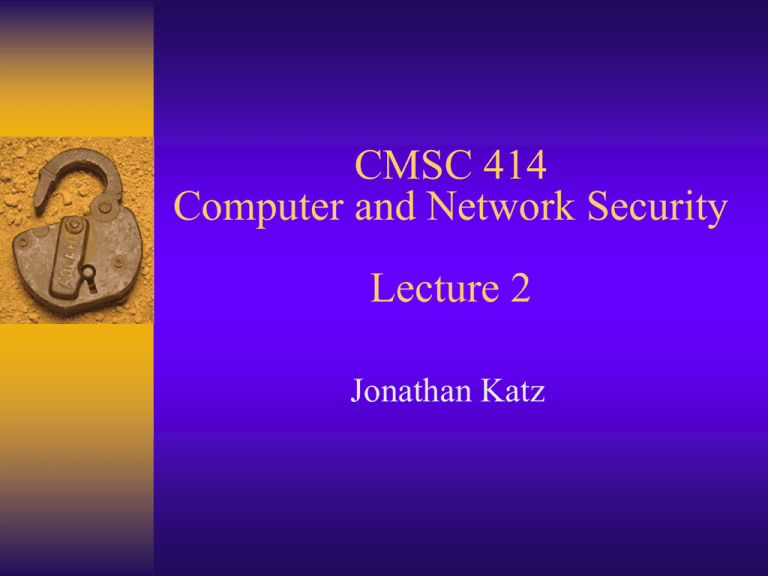
CMSC 414 Computer and Network Security Lecture 2 Jonathan Katz Administrative items I No final project Instead, 5 (more difficult) homeworks – Work in teams of two students – Email TAs if you need a partner – All students expected to work on each portion of the homework First homework out Administrative items II JCE tutorial: Tuesday at 5:30. Room to be announced. Everything you wanted to know * about cryptography *But perhaps were afraid to ask… Caveat Everything I present will be (relatively) informal – But I will try not to say anything that is an outright lie… Cryptography is about precise definitions, formal models, and rigorous proofs of security (which we will not cover here) – If you want more details, take CMSC 456! Attacks Crypto deals primarily with three goals: – Confidentiality – Integrity (of data) – Authentication (of resources, people, systems) Other goals also considered – E.g., non-repudiation – E-cash (e.g., double spending) – General secure multi-party computation Security through obscurity? Always assume full details of crypto protocols and algorithms are public – Only secret information is a key “Security through obscurity” is a bad idea… Private- vs. public-key For many security goals, there are two types of cryptographic algorithms – Private-key / shared-key / symmetric-key / secret-key – Public-key Private-key cryptography The parties communicating share a completely random and secret key – Main point: key is not known to an attacker – This key must be shared (somehow) before they communicate All “classical” cryptosystems are private- key based Can also be used for secure storage Private-key cryptography For confidentiality: – Private-key (symmetric-key) encryption For data integrity: – Message authentication codes – (sometimes called cryptographic checksums) Public-key cryptography One party (Alice) generates both a public key and a private key (or secret key) The public key is published; the private key is kept secret – An attacker knows the public key! The other communicating party (Bob) need not have any key of his own; knows Alice’s key Techniques for this first developed in the 70’s Public-key cryptography For confidentiality: – Public-key encryption For data integrity: – Digital signatures To review… Confidentiality: – Private-key encryption (schemes) – Public-key encryption (schemes) Integrity: – Message authentication (codes) – Digital signature (schemes) We will discuss authentication later Private- vs. public-key I Disadvantages of private-key – Need to securely share a key • If you can share a key securely, why not just share the message itself? • What if not possible? • Need to know with whom you wish to communicate in advance! – O(n2) keys needed for point-to-point channels in an n-party network Private- vs. public-key II Why study private-key at all? – Private-key is much more efficient (3 orders of magnitude) – Public-key crypto is “harder” to get right • Needs stronger assumptions, more math – Can combine private-key with public-key to get the best of both worlds (for encryption) Private- vs. public-key III More disadvantages of public-key crypto – Public-key crypto still requires secure distribution and binding of public keys (PKI) • May (sometimes) be just as hard as sharing a key – Not clear with whom you are communicating (for public-key encryption) In more detail… Alice and Bob share a key K – Must be shared securely – Must be completely random – Must be kept completely secret from attacker – We don’t discuss (for now) how they do this Plaintext - encryption - ciphertext - decryption Decryption must recover the message! We have not yet said anything about security…
